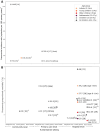Childhood pneumonia in humanitarian emergencies in low- and middle-income countries: A systematic scoping review
- PMID: 35425592
- PMCID: PMC8980764
- DOI: 10.7189/jogh.12.10001
Childhood pneumonia in humanitarian emergencies in low- and middle-income countries: A systematic scoping review
Abstract
Background: Humanitarian emergencies increase many risk factors for pneumonia, including disruption to food, water and sanitation, and basic health services. This review describes pneumonia morbidity and mortality among children and adolescents affected by humanitarian emergencies.
Methods: We searched MEDLINE, EMBASE, and PubMed databases for publications reporting pneumonia morbidity or mortality among children aged 1 month to 17 years in humanitarian emergencies (eg, natural disaster, armed conflict, displacement) in low- and middle-income countries (LMICs).
Results: We included 22 papers published between January 2000 and July 2021 from 33 countries, involving refugee/displaced persons camps (n = 5), other conflict settings (n = 14), and natural disaster (n = 3). Population pneumonia incidence was high for children under 5 years of age (73 to 146 episodes per 100 patient-years); 6%-29% met World Health Organization (WHO) criteria for severe pneumonia requiring admission. Pneumonia accounted for 13%-34% of child and adolescent presentations to camp health facilities, 7%-48% of presentations and admissions to health facilities in other conflict settings, and 12%-22% of admissions to hospitals following natural disasters. Pneumonia related deaths accounted for 7%-30% of child and adolescent deaths in hospital, though case-fatality rates varied greatly (0.5%-17.2%). The risk for pneumonia was greater for children who are: recently displaced, living in crowded settings (particularly large camps), with deficient water and sanitation facilities, and those who are malnourished.
Conclusion: Pneumonia is a leading cause of morbidity and mortality in children and adolescents affected by humanitarian emergencies. Future research should address population-based pneumonia burden, particularly for older children and adolescents, and describe contextual factors to allow for more meaningful interpretation and guide interventions.
Copyright © 2022 by the Journal of Global Health. All rights reserved.
Conflict of interest statement
Competing interests: The authors completed the ICMJE Unified Competing Interest Rorm (available upon request from the corresponding author), and declare no conflicts of interest.
Figures



References
-
- Checchi F, Gayer M, Grais R, Mills EJ. Public health in crisis-affected populations. A practical guide for decision-makers. 2007.
-
- WHO/UNICEF. Ending Preventable Child Deaths from Pneumonia and Diarrhoea by 2025: The integrated Global Action Plan for Pneumonia and Diarrhoea (GAPPD). Geneva: WHO; 2013. - PubMed
Publication types
MeSH terms
Substances
LinkOut - more resources
Full Text Sources
Miscellaneous
